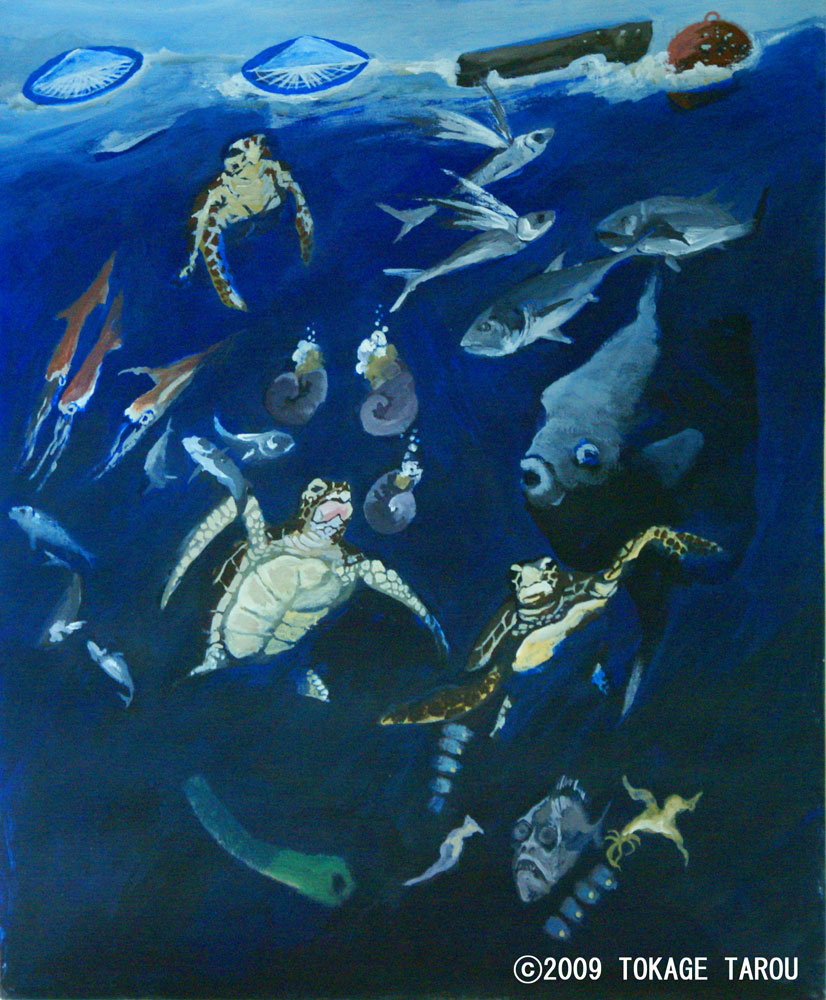
|
|
|
|
| (January, 2009) |

|
National Oceanic and Atmospheric Administration (NOAA) and the Port of Nagoya Public Aquarium have been conducting the program of satellite tagged loggerhead sea turtles since 2003.
The turtles were transported to the release point by the Aichi Maru of Miya Fisheries High School on April 2007.
Prior to the departure of Aichi Maru from the Port of Nagoya to Hawaii, Dr. George H. Balazs, Leader of the Marin Turtle Research Program at NOAA Fisheries Pacific Islands Fisheries Science Center, and Marc Rice, Director of the sea turtle Research Program at Hawaii Preparatory Academy (HPA), carefully attached satellite tags to the carapace of juvenile loggerhead sea turtles.

|
First, salt water was washed away from the turtles. Then the carapace had to be sanded in order to make the platform with elastomer for the tag. The sand paper was not rough, so turtles did not feel pain during this process. Finally, fiberglass was applied to protect the tag. They did this painstaking procedure on all 40 turtles with the students from HPA. “Students learned quickly and devoted their role when they were on board. We all had lifetime experience” said Dr. Balazs. Satellite transmissions provide not only locations of the turtles but also their swimming speed and diving depth. All data will be analyzed to understand the movement and the behavior of loggerhead sea turtles in the North Pacific Ocean. Knowing that helps to reduce loggerhead sea turtles bycatch in the pelagic longline fishery. |

|
This image is the Kuroshio Extension Current Region. |
Turtles were released in the area about 32 degrees North latitude and 176 degrees East longitude. This particular area where closed to International Date Line, which has been recognized as a hot spot of juvenile turtles from the previous satellite research. Tagged Turtles' adventure started from here even though some of them had never felt wave and scent of ocean before.
What do they eat in the middle of high seas?
Denise M. Parker, Researcher of NOAA's Pacific Islands Fisheries Science Center in Oregon, makes maps and records the data from the satellite. He explained about the diet of loggerhead sea turtles.
"Loggerhead sea turtles change prey items throughout their life. When they are young in the open ocean, they eat animals that float on the surface such as Vellela, Janthina, lepas. In addition they also dive a little deeper to catch pyrosoma, salps or even heteropods, since the prey items are not evenly distributed over the entire ocean."

|
|
||||||||||
|
Researchers found several carcasses of animals in the stomach contents of the loggerheads sea turtles. It is very important to understand the diet of loggerheads for the conservation. In the open ocean they spend about 80% of their time within 10m of the surface, presumably of their diets. So the prohibition of shallow sets in the fishery reduced the incidental catch substantially. |
|||||||||||
But still, how do young turtles find tiny mollusks? They cannot pick one by one in the vast North Pacific Ocean to fulfill their belly. “Several factors such as the temperature variation, currents, chlorophyll front, must be linked together to solve this question,” he said.
From the analysis of the satellite data, the researchers have found out that turtles stay close to 18 degree Celsius temperature line when they move across North Pacific Ocean.
"This specific temperature value of 18 degree Celsius in the North Pacific represents an area where things aggregate together at the surface of the ocean. The prey items that loggerheads eat are animals cannot move on their own or can swim little, so they would easily accumulate in the current of the surface waters. This could be like a long buffet Line for turtles," said Researcher Evan A. Howell who is also the turtle expert at NOAA’s Pacific Islands Fisheries Science Center. This discovery was a significant for conservation of loggerhead sea turtles.
When the longline fisheries harvest tuna and sword fish in the North Pacific, they hook loggerheads in accident. Therefore NOAA recommended the fisheries to avoid this region and that actually reduced the number of bycatch.
The movement creates life
Dr. Jeffrey J. Polovina, Chief of the Ecosystem and Oceanography Division at the NOAA Pacific islands Fisheries science center, is an inventor of the EcoPath model. The Ecopath is the system can outlook ecological changes in both costal and open sea region. He has been following the tagged turtles to scrutinize how intricate ecological system works in the open ocean.

Dr. Polovina explained about the connection among diverse features of ocean.
"In the open ocean surface currents such as meanders and eddies provide habitats to Animals, just like corals and sea grasses do in the coastal regions. These ocean features consist of horizontal convergences and vertical upwellings which are like winds on the ground. Movements of water bring nutrition which is accumulated in the deep up to the surface. Then phytoplankton thrives and that leads concentration of zooplankton. Afterward food webs expand to higher level predators including turtles, whale sharks, tunas, sword fish, squid, and other fishes."
For this reason loggerheads sea turtles are following Kuroshio Extension Current meander where colder productive water meets with warmer subtropical water.
 meander Meander runs through between cold and warm water. |
 Eddy When meander breaks by winding through between warm and cold water, that creates eddies. Eddies are swirls of water, the sizes are from dozens to hundreds km in diameter. |
"Turtles are using eddy effectively to catch preys. The Turtles travel around the edge of eddy, one trip takes about a month and they do this for 4 months. Since the speed of the turtles is about same as eddy, probably they ride on the current. In this region upwelling conveys deeper preys to near the surface, so basically they do not have to chase preys either," he said.

The blue arrows shows are showing the track of one turtle’s movement.
The movement indicates that the turtle swims along the eddy.
(The image provided by NOAA)
Everybody gets together

|

|
However there is a problem, big shark like the blue shark is also coming to this zone. Small turtles are vulnerable to these predators. Meanwhile fish boats aim to bigeye tuna and swordfish which are popular around turtles’ feeding place is also working nearby. Although scientists do not know how the turtles avoid predators yet, the impact of human is decreasing. Recently regulations have been passed that require longline fisheries to use larger hooks and mackerel instead of squid as bait. Since the turtles less attract to mackerel and large hooks are too big for them to swallow, the turtles are able to escape from being entangled accidentally. Moreover fisheries must stop operation when 17 loggerheads are hooked. |
For Future
From the result of several research, loggerhead sea turtles born in Japan swim along with Kuroshio Current to North Pacific Current and they spend 2 to 6 years moving from west to east around that region. Then they go further east and stay off shore of the U.S. west coast. When they are matured, they back to natal beaches in Japan and remain in the western Pacific.

|
|
After a pelagic phase of their life adult or subadult, loggerheads moves into a neritic phase (nearshore). When loggerheads are in Baja California, they eat red pelagic crabs that are in high abundance in that area and small fish. Then they migrate to East China Sea area where they feast crabs, invertebrates and some fish in the sea floor deep down 100m-300m below surface. |
|
Dr. Balazs is studying and protecting sea turtles for 35 years. "All 7 species of sea turtles have different diets and lifecycle. Naturally size and age affect their behavior too. Moreover differences exist even in the same life stage and species depend on the geographic region. Turn to loggerheads sea turtles we have been solving several aspects of their oceanic life, but our knowledge about them is still scattered and limited. That is why we are all so interested and motivated in the work we have been doing together to protect this magnificent animal," he said. |
 (Photo provided by NOAA) |
Dr. Polovina thinks that communication with public and students is very important along with scientific research and do have public talk and lecture.
He told us about surprising marine ecosystem.
 Solving the Spiny Lobster mystery by Dr. Polovina is our next story!!
Solving the Spiny Lobster mystery by Dr. Polovina is our next story!!